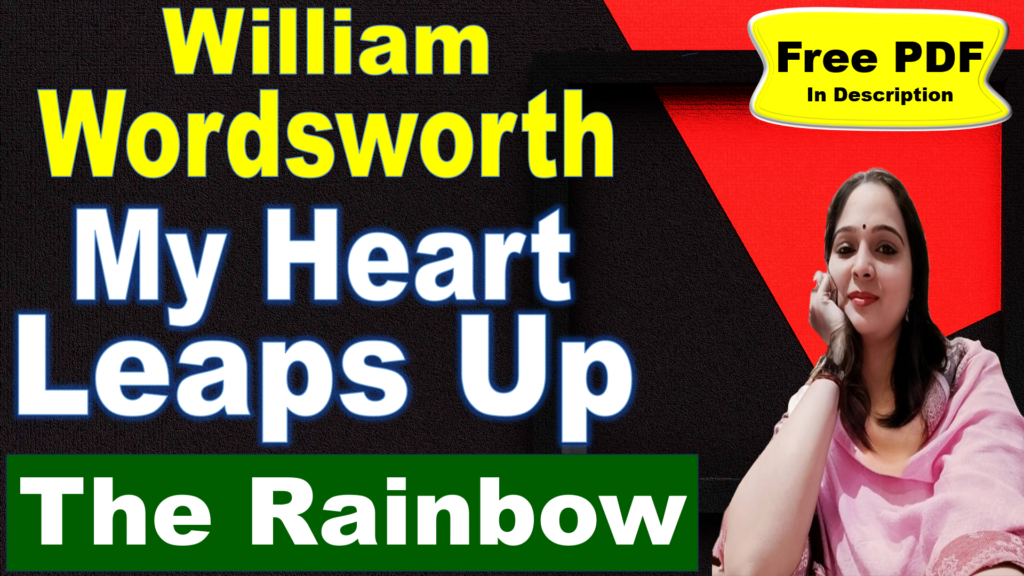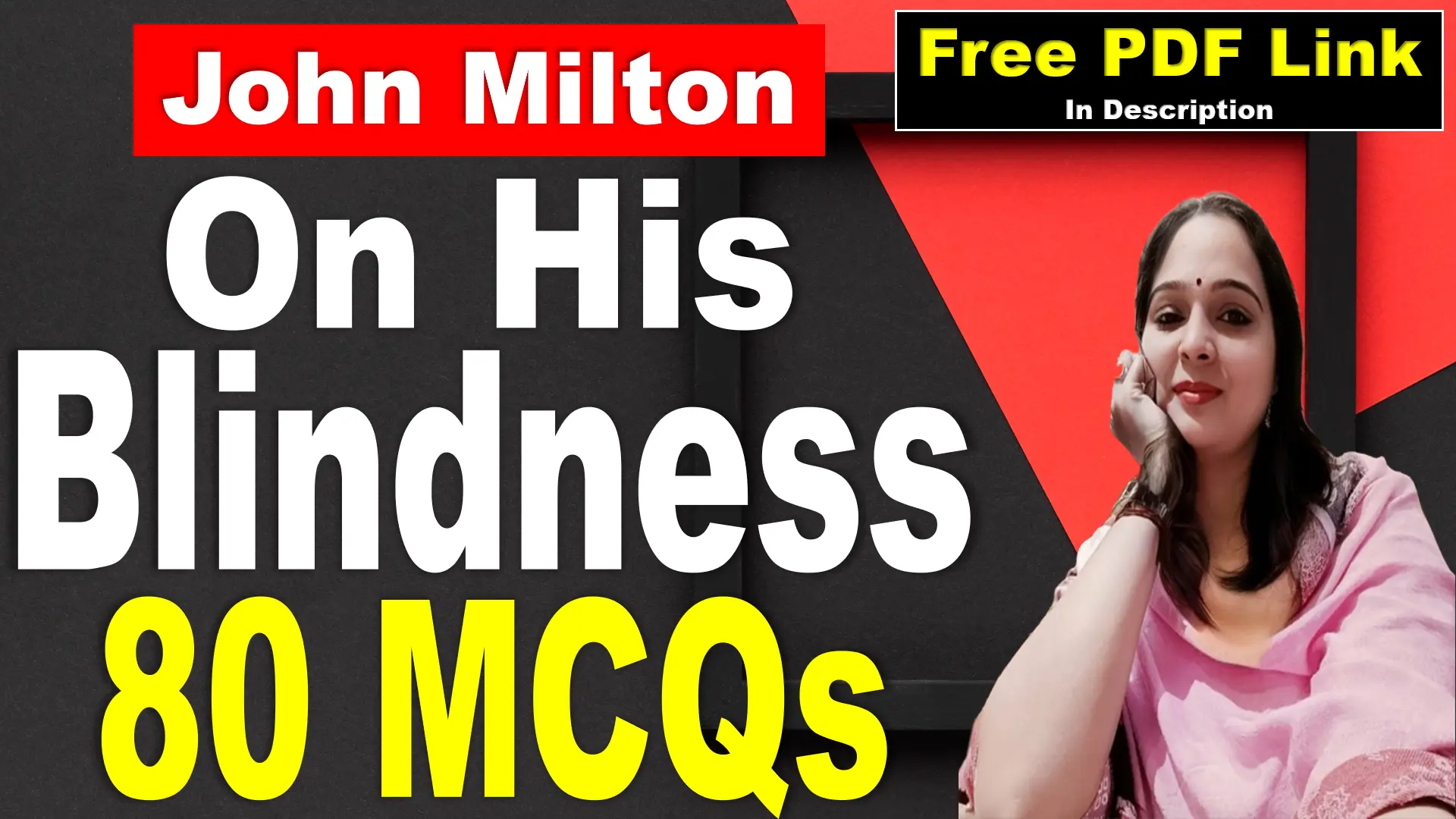
My Heart Leaps Up by William Wordsworth | The Rainbow | My Heart Leaps Up | William Wordsworth | Explanation | Summary | Key Points | Word Meaning | Critical Appreciation | Questions Answers | Free PDF Download – Easy Literary Lessons
My Heart Leaps Up
The Rainbow
(William Wordsworth)
My heart leaps up when I behold
A Rainbow in the sky:
So was it when my life began;
So is it now I am a man;
So be it when I shall grow old,
Or let me die!
The Child is father of the man;
And I wish my days to be
Bound each to each by natural piety.
My Heart Leaps Up line-by-line explanation
My heart leaps up when I behold
A Rainbow in the sky:
Explanation: In the lines “My heart leaps up when I behold / A Rainbow in the sky,” the poet, William Wordsworth, expresses a spontaneous and intense feeling of joy and wonder when he sees a rainbow. The phrase “my heart leaps up” conveys a strong emotional response, as if his heart literally jumps with happiness at the sight. The rainbow, a beautiful and fleeting natural phenomenon, symbolizes something pure and awe-inspiring in nature.
This reaction isn’t just about the physical beauty of the rainbow but also about the deeper, emotional connection that Wordsworth feels with the natural world. It reflects how certain natural sights can evoke a powerful, almost childlike joy, reminding him of the simple pleasures and the enduring significance of nature in his life. The rainbow, in this context, becomes a symbol of that joy, a consistent source of inspiration and delight from childhood through adulthood.
Imagery: Wordsworth uses vivid imagery to create a mental picture of a rainbow in the sky, evoking the beauty of nature and the emotional response it inspires. The image of a rainbow is both visually striking and symbolically rich.
Personification: The phrase “My heart leaps up” attributes human qualities to the poet’s heart, making it seem as though his heart is physically jumping with joy. This personification helps convey the intensity of the poet’s emotional response.
Enjambment: The sentence flows from one line to the next without a pause, a poetic device called enjambment. This creates a sense of continuity and movement, mirroring the sudden, continuous surge of emotion that Wordsworth feels when he sees the rainbow.
So was it when my life began;
So is it now I am a man;
So be it when I shall grow old,
Or let me die!
Explanation: In these lines from William Wordsworth’s poem “My Heart Leaps Up,” the poet reflects on the continuity of his emotional response to nature throughout different stages of his life:
“So was it when my life began;”
Wordsworth is saying that the joy and wonder he feels when he sees a rainbow have been with him since the very beginning of his life, from childhood. This indicates that his connection to nature is deep-rooted and has always been a part of him.
“So is it now I am a man;”
He continues by stating that even as an adult, he still experiences the same joy and wonder when he sees a rainbow. This line emphasizes that the emotions and connections he formed in childhood have persisted into his adult life.
“So be it when I shall grow old,”
Wordsworth expresses a hope that this feeling will remain with him as he grows older. He wishes that his appreciation for the beauty of nature, symbolized by the rainbow, will continue to bring him joy throughout his life, even into old age.
“Or let me die!”
This is a powerful statement where Wordsworth declares that if he ever loses this deep emotional connection to nature, life would no longer be worth living for him. It highlights how essential this bond with nature is to his sense of purpose and meaning in life.
Together, these lines convey Wordsworth’s belief that the joy and wonder we feel in response to nature should remain a constant in our lives, from childhood through adulthood and into old age. If this connection is lost, he suggests, life would lose its value.
Poetic Device
1. Anaphora
Definition: Anaphora is the repetition of a word or phrase at the beginning of successive clauses or lines.
In the Poem: The word “So” is repeated at the beginning of three consecutive lines (“So was it,” “So is it,” “So be it”), which emphasizes the continuity of the speaker’s emotions throughout different stages of life.
2. Parallelism
Definition: Parallelism is the use of components in a sentence that are grammatically the same or similar in their construction, sound, meaning, or meter.
In the Poem: The structure of the lines “So was it when my life began;” / “So is it now I am a man;” / “So be it when I shall grow old” follows a similar grammatical pattern, creating a rhythm that reinforces the idea of an unbroken connection between the different stages of life.
3. Temporal Shift
Definition: A temporal shift occurs when a narrative moves through different points in time.
In the Poem: The poem shifts through different stages of life—childhood (“when my life began”), adulthood (“now I am a man”), and old age (“when I shall grow old”)—to show that the speaker’s feelings towards nature remain unchanged.
4. Hyperbole
Definition: Hyperbole is an exaggerated statement or claim not meant to be taken literally.
In the Poem: The line “Or let me die!” is an example of hyperbole. Wordsworth uses this exaggeration to stress how crucial it is for him to maintain his emotional connection to nature; without it, life would lose its meaning.
5. Contrast
Wordsworth places the ideas of growing old and dying side by side, creating a stark contrast. This juxtaposition emphasizes the intensity of his conviction: he would rather die than lose his ability to feel joy and wonder at the sight of a rainbow.
The Child is father of the man;
And I wish my days to be
Bound each to each by natural piety.
Explanation: In the line “The Child is father of the man,” Wordsworth presents a paradoxical yet profound idea. He suggests that the experiences and characteristics of childhood shape and influence the adult a person becomes. In this sense, the “child” metaphorically gives birth to, or “fathers,” the “man.” The idea is that our early years are foundational, with the innocence, joy, and wonder we experience as children playing a crucial role in determining our adult selves.
The following lines, “And I wish my days to be / Bound each to each by natural piety,” express Wordsworth’s desire for his life to be connected through a consistent reverence for nature. “Natural piety” refers to a deep, almost spiritual respect and devotion to the natural world. He wishes that every stage of his life, from childhood through adulthood to old age, will be united by this ongoing, sincere relationship with nature.
Together, these lines encapsulate Wordsworth’s belief in the importance of retaining the purity and wonder of childhood throughout life. He aspires to live in a way that honors the natural world, with each day connected to the next by this enduring sense of awe and respect.
Poetic Device
Paradox: The phrase “The Child is father of the man” is a paradox, a statement that appears contradictory but reveals a deeper truth. Here, Wordsworth suggests that the qualities, experiences, and emotions of childhood shape and influence the adult we become. The child, in this sense, “fathers” or gives rise to the adult, highlighting the formative power of early life.
Symbolism: The “Child” and the “man” symbolize different stages of life—youth and adulthood. The idea that the child “fathers” the man symbolizes how our adult character is deeply rooted in our childhood experiences and perceptions.
Enjambment: The sentence flows across the lines without a pause, known as enjambment. This technique reflects the continuous and unbroken nature of the poet’s wish for his days to be interconnected by “natural piety.”
Imagery: “Bound each to each by natural piety” evokes an image of days linked together like a chain, unified by a sense of reverence and respect for nature. The phrase “natural piety” refers to a deep, almost spiritual devotion to the natural world, suggesting that Wordsworth desires his life to be marked by a consistent, heartfelt connection to nature.
Metaphor: The phrase “Bound each to each” uses the metaphor of binding or linking to describe how Wordsworth wants his days to be interconnected by a shared principle—his natural piety. It conveys the idea that this reverence for nature should be a continuous thread running through his life.





